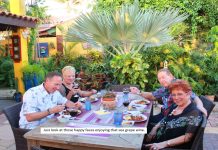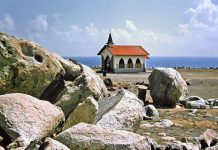

Long before writing was developed, people recorded events, ideas, plans, and feelings by marking them on a rock. Sometimes they carved into the stone. Sometimes they scratched off a surface coating. Sometimes they painted on the rocks. The method that they used was typically determined by the availability of color pigments to be used as paint, the hardness of the rocks, and the availability of tools that could be used to produce their message. 
All of these markings are referred to as “Rock Art.” People worldwide have been producing rock art for thousands of years. Some of their messages can still be seen today. The oldest are usually found in rock shelters and caves where they are protected from the wind, rain, salt and sun light. However, in arid climates as ours some examples of rock art have persisted for ten to fifteen thousand years, depending upon how the art was produced, the direction that it faces, and the type of rock used as a “canvas.” There are two basic types of rock art at this particular site, petroglyphs and pictographs. Petroglyph is an image that is carved into a rock. This “carving” can produce a visible indentation in the rock, or it can simply be the scratching away of a weathered surface to reveal unweathered rock of a different color below. The two headed deity of the legendary twins is carved into pinkish granite exposing the more gray colored stone, shown here near the top of this article is one of the Siribana site petroglyph. The prehistoric artist must have scratched the surface of the rock with probably a lithic tool. This work produced an indentation in the rock and also exposed an unweathered material of lighter color below.  This next petroglyphs shown, is a recurring design of which we find back on various sites on the Island and else ware, whether as pictograph or like here as a petroglyph. This drawing is referred to, as a portal design, a door way a hole in the sky in which you could be transported in to the spiritual world. Siribana rock formation that lies some 1500 meters north-east of the Catholic Church of Santa Cruz, it`s very beautiful and in the open air place where starry nights and full moons assemblies were held, honoring the sky spirits. It does not show many big Batholith boulders upon the surface as at other sites illustrated in our previous articles. However these boulders are present, but not visible since most of them are under ground level and what we can observe is merely the tips or heads of the emerging boulders out of the ground level. Siribana is the only known site that we can depict Petroglyph on the whole island. Petroglyphs, as described earlier are designs that have been scratched, carved or chiseled on the rock surface, exposing the less weathered rock, in this case lighter colored stone, which on its part gives the expression its contrast. A stone that has been long exposed to the elements tends to have form a different outer layer or crust color.
This next petroglyphs shown, is a recurring design of which we find back on various sites on the Island and else ware, whether as pictograph or like here as a petroglyph. This drawing is referred to, as a portal design, a door way a hole in the sky in which you could be transported in to the spiritual world. Siribana rock formation that lies some 1500 meters north-east of the Catholic Church of Santa Cruz, it`s very beautiful and in the open air place where starry nights and full moons assemblies were held, honoring the sky spirits. It does not show many big Batholith boulders upon the surface as at other sites illustrated in our previous articles. However these boulders are present, but not visible since most of them are under ground level and what we can observe is merely the tips or heads of the emerging boulders out of the ground level. Siribana is the only known site that we can depict Petroglyph on the whole island. Petroglyphs, as described earlier are designs that have been scratched, carved or chiseled on the rock surface, exposing the less weathered rock, in this case lighter colored stone, which on its part gives the expression its contrast. A stone that has been long exposed to the elements tends to have form a different outer layer or crust color.  The particular incision in this rock looks very similar to one pictograph representing the Hopi Bow clan, keepers of the fire in Arizona, United States. However we did not receive confirmation till now, whether this carving shown on this picture above was considered to be recent carving by modern Arubans or that it has been completely ignored by experts.
The particular incision in this rock looks very similar to one pictograph representing the Hopi Bow clan, keepers of the fire in Arizona, United States. However we did not receive confirmation till now, whether this carving shown on this picture above was considered to be recent carving by modern Arubans or that it has been completely ignored by experts.
During the course of a few decades, this site has become almost impossible to reach. This due to the less hospitable conditions that have formed in relation to former access routes for visitors. A very difficult terrain to it has become when going up from the southern road for the less experienced outdoors men. A thick xerophytic vegetation has covering a great part of what used to be old paths use by the natives to climb up to these mystical grounds since bay gone times. The vegetation has taking over wherever it could. This phenomenon, of xenophiles over growth has in become a great problem and very much covered by this big thorny Acacia shrub known locally as Hubada. Pap.“ Who–bâ-da” Acacia turtuosa Lin. This Acacia, together whit a list of introduced and invasive plants and animals are doing irreversible harm to our fragile ecosystem. Let’s be conscious and protect our local species since every day is Earth Day! 
Discover an Aruba that no other could share with you. Our renowned indigenous and educative session has been entertaining curious participants for decades. Mail us at etnianativa03@gmail.com to confirm your participation at our facilities, close to the high rise Hotels area, and take this experience home with you.











